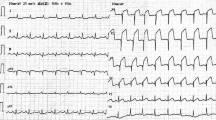Abstract
Ventricular septal rupture (VSR) is an uncommon but fatal mechanical complication of myocardial infarction (MI). It should be diagnosed as early as possible because it carries a very high mortality rate. Surgical closure remains the main line of treatment. A 75-year-old female patient presented with neglected extensive anterior STEMI. Clinical examination revealed pansystolic murmur over the left lower sternal border. 2D echo showed VSR and severe TR with normal right side dimensions and function. 3D Echo revealed that the cause of acute TR was the VSR left to right shut. Coronary angiography showed total LAD occlusion. The patient developed cardiogenic shock shortly after admission and died before surgery. This case demonstrated a rare mechanical complication of VSR. It signified the importance of cardiac auscultation, the strength of 3D echo in diagnosing structural heart disease. It also highlighted the disastrous impact of acute ischemic mechanical complications.







Similar content being viewed by others
Data Availability
For any queries or requests, kindly contact the corresponding author.
Code Availability
Not applicable.
Abbreviations
- VSR:
-
Ventricular septal rupture
- TR:
-
Tricuspid regurgitation
- CAD:
-
Coronary artery disease
- MI:
-
Myocardial infarction
- STEMI:
-
ST segment elevation myocardial infarction
- 2D:
-
Two-dimensional
- 3D:
-
Three-dimensional
- LAD:
-
Left anterior descending artery
- LCx:
-
Left circumflex artery
- RCA:
-
Right coronary artery
- ECG:
-
Electrocardiogram
- NSR:
-
Normal sinus rhythm
- LIMA:
-
Left internal mammary artery
References
Mathers CD, Loncar D. Projections of global mortality and burden of disease from 2002 to 2030. PLoS med. 2006;3(11):e442.
Öberg M, Jaakkola MS, Woodward A, Peruga A, Prüss-Ustün A. Worldwide burden of disease from exposure to second-hand smoke: a retrospective analysis of data from 192 countries. Lancet. 2011;377(9760):139–46.
French JK, Hellkamp AS, Armstrong PW, Cohen E, Kleiman NS, O’Connor CM, et al. Mechanical complications after percutaneous coronary intervention in ST-elevation myocardial infarction (from APEX-AMI). Am J Cardiol. 2010;105(1):59–63.
Birnbaum Y, Fishbein MC, Blanche C, Siegel RJ. Ventricular septal rupture after acute myocardial infarction. N Engl J Med. 2002;347(18):1426–32.
Lopez-Sendon J, Gurfinkel EP, Lopez de Sa E, Agnelli G, Gore JM, Steg PG, et al. Factors related to heart rupture in acute coronary syndromes in the Global Registry of Acute Coronary Events. Eur Heart J. 2010;31(12):1449–56.
Moreyra AE, Huang MS, Wilson AC, Deng Y, Cosgrove NM, Kostis JB, et al. Trends in incidence and mortality rates of ventricular septal rupture during acute myocardial infarction. Am J Cardiol. 2010;106(8):1095–100.
Jones BM, Tuzcu EM, Kapadia SR, Menon V, Krishnaswamy A, Robich M, et al. Ventricular septal rupture complicating acute myocardial infarction: a contemporary review. Eur Heart J. 2014;35(31):2060–8. https://doi.org/10.1093/eurheartj/ehu248.
Koh AS, Loh YJ, Lim YP, Tan JL. Ventricular septal rupture following acute myocardial infarction. Acta Cardiol. 2011;66(2):225–30.
Menon V, Webb JG, Hillis LD, Sleeper LA, Abboud R, Dzavik V, et al. Outcome and profile of ventricular septal rupture with cardiogenic shock after myocardial infarction: a report from the SHOCK Trial Registry. J Am Coll Cardiol. 2000;36(3 Supplement 1):1110–6.
Yip H-K, Fang C-Y, Tsai K-T, Chang H-W, Yeh K-H, Fu M, et al. The potential impact of primary percutaneous coronary intervention on ventricular septal rupture complicating acute myocardial infarction. Chest. 2004;125(5):1622–8.
Author information
Authors and Affiliations
Contributions
Moustafa Dawood performed the 2D echo at presentation and discovered the VSR. Hoda Shehata and Rasha Aba-yazeed performed the 3D echo and linked the VSR to the acute severe TR. Ahmed El Amrawy performed the coronary angiography. Mohamed Abdel-Hay was the head of our echo lab and revised the case. All the authors read and approved the final manuscript.
Corresponding author
Ethics declarations
Ethics Approval
Not applicable.
Consent to Participate
Not applicable.
Consent for Publication
The patient’s relatives approved the publication and signed the consent.
Conflict of Interest
The authors declare no competing interests.
Additional information
Publisher's Note
Springer Nature remains neutral with regard to jurisdictional claims in published maps and institutional affiliations.
This article is part of the Topical Collection on Medicine
Supplementary Information
Below is the link to the electronic supplementary material.
Supplementary file1 (AVI 2071 kb)
Supplementary file2 (WMV 656 kb)
Supplementary file3 (AVI 2188 kb)
Supplementary file4 (AVI 4293 kb)
Supplementary file5 (AVI 8450 kb)
Supplementary file6 (AVI 1743 kb)
Rights and permissions
About this article
Cite this article
Dawood, M., Shehata, H., Abayazeed, R. et al. Ventricular Septal Rupture Causing Acute Severe Tricuspid Valve Regurgitation in the Setting of a Neglected Myocardial Infarction: a Case Report. SN Compr. Clin. Med. 4, 76 (2022). https://doi.org/10.1007/s42399-022-01157-6
Accepted:
Published:
DOI: https://doi.org/10.1007/s42399-022-01157-6




